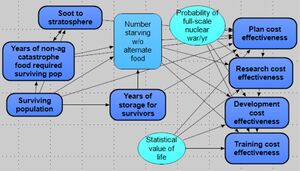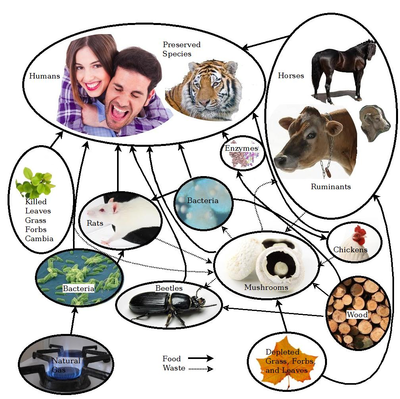J.M.Pearce (talk | contribs) m (→See Also) |
(Set shorter title-tag for SEO purposes) |
||
| (15 intermediate revisions by 6 users not shown) | |||
| Line 1: | Line 1: | ||
{{MOST}} | {{MOST}} | ||
[[File:Coseffective.jpg|thumb]] | |||
{{Source data | |||
| type = Paper | |||
| cite-as = David C. Denkenberger & Joshua M. Pearce. [https://doi.org/10.1016/j.ijdrr.2017.10.014 Cost-effectiveness of interventions for alternate food in the United States to address agricultural catastrophes]. ''International Journal of Disaster Risk Reduction'' 27 (2018), pp. 278-289. https://doi.org/10.1016/j.ijdrr.2017.10.014 [https://www.academia.edu/34953571/Cost-effectiveness_of_interventions_for_alternate_food_in_the_United_States_to_address_agricultural_catastrophes open access] | |||
}} | |||
The literature suggests there is ~0.3 percent chance per year of full-scale nuclear war. This event would have ~20 percent probability of causing U.S. mass starvation due to collapse of conventional agriculture from smoke blocking the sun. Alternate foods exploit fossil fuels (e.g. methane digesting bacteria) and stored biomass (e.g. mushrooms growing on dead trees) and are technically capable of saving all Americans from starving. However, current awareness is low and the technologies need to be better developed. This Monte Carlo study investigates the economics of three interventions including planning, research and development. Even the upper bound of $20,000 per life saved is far lower than the millions of dollars typically paid to save an American life. Therefore, it should be a high priority to implement these interventions as they would improve American resilience and reduce the possibility of civilization collapse. | The literature suggests there is ~0.3 percent chance per year of full-scale nuclear war. This event would have ~20 percent probability of causing U.S. mass starvation due to collapse of conventional agriculture from smoke blocking the sun. Alternate foods exploit fossil fuels (e.g. methane digesting bacteria) and stored biomass (e.g. mushrooms growing on dead trees) and are technically capable of saving all Americans from starving. However, current awareness is low and the technologies need to be better developed. This Monte Carlo study investigates the economics of three interventions including planning, research and development. Even the upper bound of $20,000 per life saved is far lower than the millions of dollars typically paid to save an American life. Therefore, it should be a high priority to implement these interventions as they would improve American resilience and reduce the possibility of civilization collapse. | ||
==Keywords== | {{Pearce publications notice}} | ||
== Keywords == | |||
existential risk; nuclear terrorism; alternate food; global catastrophic risk; Monte Carlo; United States | existential risk; nuclear terrorism; alternate food; global catastrophic risk; Monte Carlo; United States | ||
== See also == | |||
{{Alt-food}} | |||
== News == | |||
* Should we be spending no less on alternate foods than AI now? [http://effective-altruism.com/ea/1g9/should_we_be_spending_no_less_on_alternate_foods/ Effective Altruism] | |||
*[ | |||
{{Page data | |||
| title-tag = Cost-Effectiveness of Alternate Food in the US | |||
}} | |||
Latest revision as of 16:02, 23 February 2024

The literature suggests there is ~0.3 percent chance per year of full-scale nuclear war. This event would have ~20 percent probability of causing U.S. mass starvation due to collapse of conventional agriculture from smoke blocking the sun. Alternate foods exploit fossil fuels (e.g. methane digesting bacteria) and stored biomass (e.g. mushrooms growing on dead trees) and are technically capable of saving all Americans from starving. However, current awareness is low and the technologies need to be better developed. This Monte Carlo study investigates the economics of three interventions including planning, research and development. Even the upper bound of $20,000 per life saved is far lower than the millions of dollars typically paid to save an American life. Therefore, it should be a high priority to implement these interventions as they would improve American resilience and reduce the possibility of civilization collapse.
Keywords[edit | edit source]
existential risk; nuclear terrorism; alternate food; global catastrophic risk; Monte Carlo; United States
See also[edit | edit source]

- Feeding Everyone No Matter What - The full book main page
- David Denkenberger and Joshua Pearce, Feeding Everyone No Matter What: Managing Food Security After Global Catastrophe , 1st Edition, Academic Press, 2015
- Free Preview: Google books
- Cover on Academia
- Facebook page
- Alternative Foods as a Solution to Global Food Supply Catastrophes
- Resilience to global food supply catastrophes
- Feeding Everyone if the Sun is Obscured and Industry is Disabled
- Cost-Effectiveness of Interventions for Alternate Food to Address Agricultural Catastrophes Globally
- Feeding Everyone: Solving the Food Crisis in Event of Global Catastrophes that Kill Crops or Obscure the Sun
- Food without sun: Price and life-saving potential
- Cost-effectiveness of interventions for alternate food in the United States to address agricultural catastrophes
- Micronutrient Availability in Alternative Foods During Agricultural Catastrophes
- Preliminary Automated Determination of Edibility of Alternative Foods: Non-Targeted Screening for Toxins in Red Maple Leaf Concentrate
- Open Source Software Toolchain for Automated Non-Targeted Screening for Toxins in Alternative Foods
- Scaling of greenhouse crop production in low sunlight scenarios
- Potential of microbial protein from hydrogen for preventing mass starvation in catastrophic scenarios
- U.S. Potential of Sustainable Backyard Distributed Animal and Plant Protein Production During & After Pandemics
- Global distribution of forest classes and leaf biomass for use as alternative foods to minimize malnutrition
- Long-term cost-effectiveness of interventions for loss of electricity/industry compared to artificial general intelligence safety
- Long term cost-effectiveness of resilient foods for global catastrophes compared to artificial general intelligence safety
- Rapid repurposing of pulp and paper mills, biorefineries, and breweries for lignocellulosic sugar production in global food catastrophes
- Nutrition in Abrupt Sunlight Reduction Scenarios: Envisioning Feasible Balanced Diets on Resilient Foods
- Methane Single Cell Protein: securing protein supply during global food catastrophes
- Killing two birds with one stone: chemical and biological upcycling of polyethylene terephthalate plastics into food
- How Easy is it to Feed Everyone? Economic Alternatives to Eliminate Human Nutrition Deficits
- Quantifying Alternative Food Potential of Agricultural Residue in Rural Communities of Sub-Saharan Africa
- Yield and Toxin Analysis of Leaf Protein Concentrate from Common North American Coniferous Trees
- Toxic Analysis of Leaf Protein Concentrate Regarding Common Agricultural Residues
- Towards Sustainable Protein Sources: The Thermal and Rheological Properties of Alternative Proteins
Additional Information[edit source]
- ALLFED
- Dave Denkenberger Publications
- OSE Wiki "Synfood" (i.e. protein and other dietary components from microbial organisms fed on gas or other hydrocarbons)
Davos IDRC Conference[edit source]
- Feeding Everyone if Industry is Disabled
- Providing Non-food Needs if Industry is Disabled
- Vitamins in Agricultural Catastrophes
- Integrative Risk Management for Catastrophe Destroying 10-20% of Global Food Supply
News[edit | edit source]
- Should we be spending no less on alternate foods than AI now? Effective Altruism






